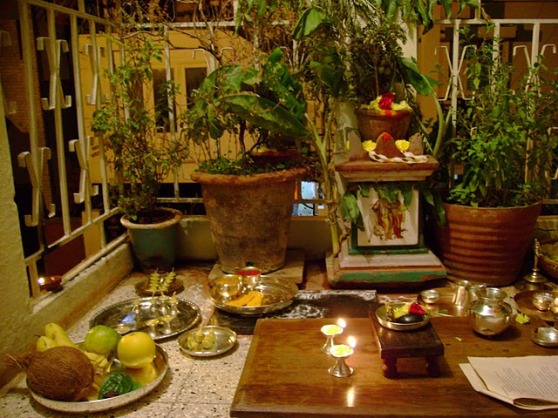
Step 1: Clean the area around the Tulsi plant. Sprinkle a little water on the tulsi plant and clean the idol ofimage or picture of Lord Vishnu (or Lord Krishna). The idol can be a substitute for the shaligram, which is generally brought by the priest who can be called to perform the Tulsi Vivah ceremony. You can do a small rangoli design in front of the tulsi plant pot.
Step 2: Prepare a thali having a diya and red flowers (hibiscus flowers can be used); and another thali containing a saree, a blouse piece, a packet of mahendi, a kohl stick or box, a box of sindoor (red vermillion powder) and a few green bangles.Also keep a thali of fruits, tamarind and amla pieces. The reason for this: The tulsi is considered to be a plant of the forest (van), so anything which grows on the trees is offered as part of the Tulsi Vivah ceremony.
Step 3: Take 4 sugarcane sticks and place it at 4 corners around the tulis plant pot, connecting them with strong threads. This is the traditional way, done in the courtyards of villages. Alternatively, you can gently insert the sugarcane sticks in the soil around the tulsi plant.
Step 4: Place a small bright cloth (this is generally red in colour and resembles a scarf or odhni) on the tulsi plant. Apply a bit of the sindoor on a leaf of the Tulsi plant. Throw the red flowers on the tulsi plant. Offer the fruits, tamarind and amla pieces. Say the Tulsi Aaarti.
Place the thali for the wedding (saree, blouse, bangles, etc) in front of the tulsi plant pot. Light the diya in the thali and perform the aarti of the tulsi plant. Apply a tika of sandalwood paste on the forehead of the idol/image/shaligram of Lord Vishnu (in some homes, a thali of men’s clothing is also offered with a sacred thread). Offer a little of the pre-pared poha dish (you can put it in the same thali as the fruits).
Step 5: Once the aarti is completed, a little of the poha is offered to family members and guests. The fruits can also be eaten later. In many homes, the lady who performed the Tulsi Vivah ceremony also eats a leaf of the tulsi plant, symbolically implying that the Goddess has entered her body.
Step 6: The thali containing the wedding items is generally offered to a Brahmini (female ascetic).
“Jai Shri Radhe”

You must be logged in to post a comment.